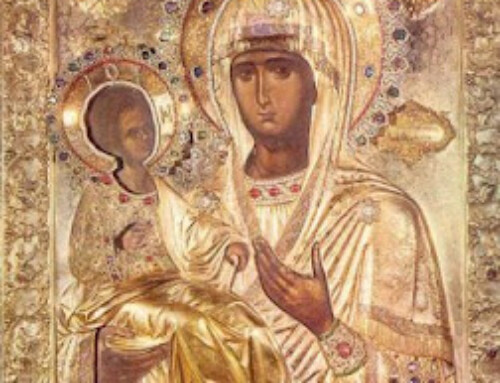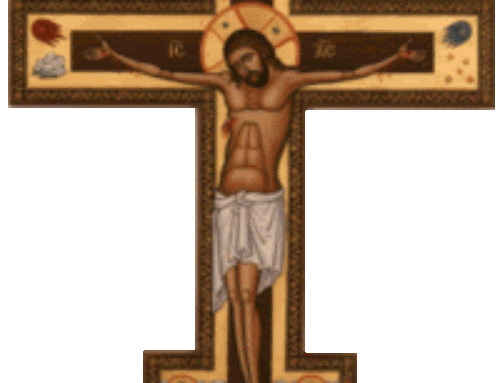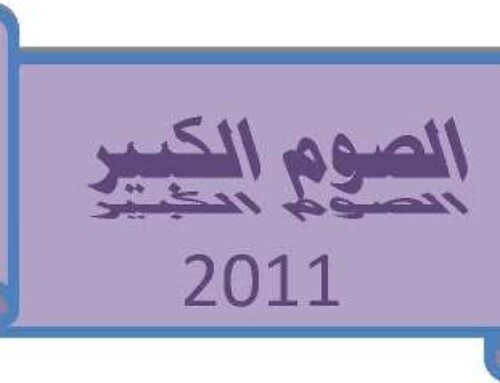LITURGICAL TERMS AND THEIR DEFINITIONS
1. ADVENT -It is of Latin origin, meaning `coming or `arrival, and is used in reference to the coming of Christ at the time of and preparation for His Nativity.
2. AER – -The largest of the three veils used to cover the diskarion and Chalice.
 3. AKATHISTOS – A Greek word meaning `not permitted to sit’. It is a long hymn composed for devotional purposes to many different saints. The Akathistos for the Theotokos is used during Lent.
3. AKATHISTOS – A Greek word meaning `not permitted to sit’. It is a long hymn composed for devotional purposes to many different saints. The Akathistos for the Theotokos is used during Lent.
4. ALLELUIA -It is of Hebrew origin, meaning `God has appeared; praise Him’. More simply, it means `Praise the Lord’.
5. AMBON – A small, raised platform or pulpit near the North door. It is used for the reading of the Gospel and for preaching.
6. ANABATHMOI -‘Hymns of Ascent’. These hymns are based on Ps. 120-134 and refer to the Church’s ascension to heaven. They are sung in Matins preceding the Prokeimenon and Gospel.
7. ANALOGION:
a) A stand on the South side of the Solea used by chanters for their books.
b) Also, the stand on which the icon (or Gospel) is placed for veneration in the middle of the church.
8. ANAPHORA – A Greek word meaning `offering’. It refers to that which is offered up at the time of consecration, as well as the hymns and prayers said at that time.
9. ANTIDORON – A Greek word meaning `instead of the gift’. It is the bread we receive after the Liturgy, originally meant only for those who did not receive communion.
10. ANTIMINSION -`In place of the table.’ It is a rectangular cloth on which lies Christ’s entombment, possibly holy relics, and the bishop’s signature giving permission to celebrate the Liturgy.
11. ANTIPHON – a) Alternate chanting between two choirs (antiphonal chant). b) A general title for a hymn or a section of the Psalter which are to be sung in such a manner.
12. APODOSIS – `Giving back’ or `return’. It is the last day of the after-feasts on which the feast finally ends. Also called the leave-taking.
13. APOLYTIKION – This term means `dismissal’. It is the dismissal hymn sung at the end of Vespers, and usually refers to the Troparion.
14. APOSTICHA – Those hymns or stichera sung at the end of Vespers as well as daily and lenten Matins. They are separated by psalm verses.
15. ARTOKLASIA – A ceremony at the end of festal Vespers where the blessing of the five loaves (Aghrypinia), wheat, wine and oil takes place following the intercessory prayers.
16. ASTERISK – The star used to cover the Lamb and other particles present of the Diskos.
17. BIER -This is the structure that houses the Epitaphion following the procession of Holy Friday Vespers, and is used to carry it in the procession of Holy Saturday Matins that evening.
18. CANON – A lengthy hymn composed of nine Odes, with each Ode being made up of the Irmos, Troparion, Theotokion and Katabasia. It is a basic element of Matins and may also appear elsewhere.
19. CANTICLE – These are songs from the Bible on which each of the nine Odes of the Canon are based. (Ode 1 follows Ex 15:1-19, e.g.)
20. CATECHUMENS – Those people being taught their catechism or doctrine of faith before they become baptized members of the Church.
21. CHALICE – The cup in which the wine is consecrated to become the blood of Christ.
22. CONCELEBRATION – When one priest assists another in serving or celebrating the sacraments.
23. DIKIRIA – The two-branched candle stick used by the bishop, signifying the two natures of Christ.
24. DISKARION (DISKOS & PATEN) – The small stand on which is prepared the Lamb of God and other particles during the Prothesis.
25. DOGMATIKON – The Theotokion sung at Vespers following the Stichera of `Lord, I have cried…’ They express the Church’s dogma of the two natures of Christ, as revealed in the Incarnation.
26. DOXASTIKON – A hymn (Stichera) that follows `Glory to the Father…’ It usually refers to the Glory of the Praises in Matins.
27. DYNAMIS – `Power.’ This is said before the last `Holy God…’ is sung in the Trisagion Hymn.
28. EINOS (pl., EINOI) – The Praises sung during Matins. Also called Lauds.
29. EISODOS – The procession or entrance, referring to either the Little or Great Entrance. Also called Introit.
30. EKTENIA (LITANY) – This means supplication or fervent prayer that comes out of the heart. These petitions call upon God’s mercy.
31. EOTHINA – Means `pertaining to the dawn’. It refers to the eleven Resurrectional Gospels (Post-Resurrectional appearances of Christ) done at Matins.
32. EPICLESIS – The calling down of the Holy Spirit by the priest at the consecration of the bread and wine.
33. EPIGONATION (PALITZA) – The diamond-shaped sword or shield worn over the right hip. It is usually given as a sign of honor as well as to those authorized to hear confessions.
34. EPIMANIKON – The cuff worn over the wrist.
35. EPITAPHION – `On the tomb.’ The large cloth (winding sheet) on which is sewn the body of Christ as lying in the tomb. (It can also refer to the table on which this is placed.)
36. EPITRACHELION The epitrachelion worn around the neck by the priest and bishop, without which they cannot serve.
37. EUCHOLOGION – The service book of the priest, containing the fixed portions of the daily offices: Vespers, Matins, Liturgy, Pre-sanctified, sacramental, funeral, etc., services; along with other blessings and prayers.
38. EVLOGISON DESPOTA – Greek for : Bless, Master!
39. EVLOGITARIA – These are Troparia sung at Matins and Funeral services, accompanied by: “Blessed art Thou, O Lord, teach me Thy statutes”.
40. EXAPOSTELARION (PHOTAGOGIKON) – `Dispatching’ or `sending out’. It is a hymn in the Matins service that deals with the sending out of the disciples and myrrh-bearing women by Christ following His resurrection. Also called `The Hymn of Light’.
41. FEEMY – This is the full title of the bishop which is said during the Liturgy in asking for `Many Years’.
42. HOROLOGION – ‘The Book of Hours.’ This is the choir book for the reader and singers, with their fixed portions of the daily offices, Troparia and Kontakia for feasts and saints’ days throughout the year.
43. HOSANNA – `O Lord, save, we pray.’
44. HYPAKOE – `To be obedient’, `to hear’ or `to respond’. This is a hymn which refers to the obedience of the myrrh-bearing women, who went to the tomb of Christ to anoint His body; but hearing of His rising, they began preaching His resurrection to all in obedience. Also refers to the hymn sung after the Third Ode in Paschal Matins.
45. ICXC NIKA -`Jesus Christ Conquer.’ It means that in the sign of the Cross of Jesus Christ thou shalt conquer.
46. IDIOMELON – A Troparion (Sticheron) having its own meter and melody which never serves as a model for other stichera.
47. INRI – Latin, Jesus Nazareourun Rex Judeorum -Jesus of Nazareth, King of the Jews.’
48. IRMOLOGION – This gives the text of the Irmoi sung at the beginning of the various Canticles of the Canon.
49. IRMOS (pl., IRMOI) – The first hymn sung in an Ode which gives the style or key to the remaining Troparia in that Ode.
50. EIS POLLA ETI DESPOTA – Greek for`Many Years, Master.’
51. JIBEE (RIASA) The black flowing robe worn by the clergy (different than the cassock).
52. KAIRON – `Time’ or `permission.’ The prayers said by the clergy prior to the Liturgy in preparation for such service.
53. KALIMAVKI – The black, perpendicular headdress, draped with the black veil, worn by monastics, archimandrites, and bishops.
54. KATABASIA `Song of descension.’ Two choirs come down from the cleros (from where they chant) to sing this last hymn of an Ode of a Canon together.
55. KATHISMA (SEDALEN) – `Sitting.” A hymn sung (or said) following the Third Ode of a Canon and in many other places where sitting is permitted.
56. KOINONIKON – Communion Hymn sung during the Divine Liturgy.
57. KONTAKION – Originally, this was a hymn composed of many stanza (18-24) whose lengthy text required the use of a scroll. What remains today are short preliminary stanzas that give a concise meaning to the feast being celebrated. It is sung following the Sixth Ode in Matins, during the Hours and after the Troparia at the Liturgy.
58. LITIYA – This word implies a fervent, prolonged prayer. It generally designates the procession to the Narthex of the church for petitions, hymns and the blessing of the five loaves, wheat, wine and oil during Great Vespers of feast days.
59. MAKARIZMOI – A Greek term referring to `The Beatitudes’.
60. MEGALYNARION (MAGNIFICATION) – A short verse, usually beginning with the word Magnify. These Megalynaria are sung at Matins after the Polyeleos on Great Feasts and on certain saint’s days (in Slav use only), and in place of the Magnificat (It is Truly Meet…) on Great Feasts.
61. MENAIA – This contains the services of the foxed feasts throughout the twelve months, from September 1 to August 31. This is usually found in twelve volumes.
62. METALEPSIS – A Greek word meaning communion. It refers to the divine communion prayers of preparation for receiving the Communion and the prayer of thanksgiving which follows.
63. METANOIA – A little prostration made by bending down to touch the ground with your hand.
64. MITRE – The crown worn by the bishop.
65. NARTHEX – The porch or vestibule of the church.
66. NAVE – The body of the church.
67. OCTOECHOS `Book of the Eight Tones.’ This contains the variable portions for the daily offices, for each tone, each day of the week.
68. ODE – `A song of praise.’ It is one of the nine divisions of the Canon, taken from certain Canticles in the Bible.
69. OIKOS – Like the Kontakion, it is a condensed form of a hymn. The Greek word means `house’, signifying that the Oikos contained all the essentials of a household. Similarly, the Oikos of the church service was a brief summary of the saint or feast day being celebrated.
70. OMOPHORION – The epitrachelion worn by the bishop which hangs down in front and behind his other vestments.
71. ORARION – The long, single-band epitrachelion worn by the deacon over his left shoulder, and by the sub-deacon crosswise over his chest.
72. PANAGIA – The `all-holy’ pectoral icon of the Theotokos worn by the bishop.
73. PARAKLESIS:
a) This may pertain to the Paracletike, the consolation we receive from the Holy Spirit (the Paraclete /Comforter).
b) This can also mean supplication, or Petition, from where we derive the two canons (the Great and Little Paraklesis) which are supplicatory hymns to the Theotokos.
74. PENTECOSTARION – This book contains the services from Pascha to the Sunday of All-Saints (the first Sunday after Pentecost).
75. PHELONION (CHASUBLE) – The outer garment worn by the priest that has no sleeves.
76. POLYELEOS – The psalms of `much oil’ or `many mercies’ (Ps. 135-6) sung during Resurrectional and Festal Matins.
77. PROEGIASMENA – This term refers to the Presanctified Liturgy.
78. PROKEIMENON -The Greek word implies something which is `set before’ or `introduces’. The Prokeimenon was originally an entire psalm which served to `introduce’ the reading of Scripture which followed it. One verse from the psalm was then selected as the refrain to the chanting of all the others. Currently, the Prokeimenon has been reduced to the refrain and one to four verses of the psalm.
79. PROSOMION (pl., PROSOMIA) – Also called PODOBEN. It is a Troparion (Sticheron) whose meter and melody are taken from that of an Automelon which serves as its model.
80. PROSPHORA – `Something given forth.’ It is the bread given to the Church to prepare for the Holy Eucharist.
81. PROTHESIS (PROSKOMIDE) – This is the preparation service done prior to the Divine Liturgy. It may refer to the table on which this is performed. Also called Offertory or Oblation for that which is being offered.
82. QUADRAGESIMA Latin for the time of the 40-day Lenten Fast.
83. SABAOTH – Hebrew for `the Powers’ or `the Hosts’.
84. SACRISTY – A small room in which the robes and extra books of the church are kept.
85. SAKKOS (DALMATIC) – This is the outer garment worn by the bishop in place of the phelonion.
86. SOLEA – The area between the Nave and the Altar. It is usually raised a step or two higher than the Nave.
87. STAVROTHEOTOKION – These are hymns to the Theotokos which refer to her standing at the cross of Christ. They are typically found in the Octoechos in the hymnography for Wednesdays and Fridays.
88. STICHARION (ALB) -The long, white undergarment worn by priests and bishops.
89. STICHERON (pl., STICHERA) – Any hymn sung which is preceded by a stichos, or psalm verse.
90. SYNAPTES – Petitions that refer either to the Great or Little Ektenia (Litany).
91. SYNAXARION – This is a collection of the accounts of the saints of God. In such a reference, the Church pictures the lives of the saints, and the content of each of their feasts, from which the purpose of the feast is clearly shown.
92. SYNAXIS – a) The gathering of the Church for worship.
-b) It can also refer to the commemoration that falls on the day after a Great Feast, honoring someone closely related to that Feast.
93. THEOTOKION A hymn to the Theotokos which usually concludes a larger body of hymnography. It is sung after the `Now and ever…’ verse.
94. TRIKIRIA – The three-branched candle stick used by the bishop which signifies the Father, Son and Holy Spirit.
95. TRIODION – `The Book of the Three Odes.’ This contains the texts for Great Lent, beginning with the Sunday of the Publican and Pharisee and concluding with Holy Saturday.
96. TRISAGION – The thrice-holy hymn `Holy God, Holy Mighty, Holy Immortal, have mercy on us’. The Trisagion Prayers begin with this hymn and continue on concluding with the Lord’s Prayer.
97. TROPARION (pl., TROPARIA) – One of the oldest titles used in the Orthodox Church for a particular piece of composed hymnography. In Greek, the word means `a sign of victory’ or a `way of life’, which implies that the composed hymn is a concise summary of the event or saintly person being celebrated. These Troparia are found at the end of Vespers, after `God is the Lord’ in Matins, after the Little Entrance in the Liturgy and as those hymns which follow the Irmos in the Ode of a Canon.
98. TYPIKON – This contains the rubrics concerning every aspect of the church services and how they are to be celebrated.
99. ZEON – The hot water poured into the Chalice after the consecration.
100. ZONE – The girdle or belt worn by the priest and bishop.
101. AMEN – Hebrew for `truly’ or `certainly’. It is an assent to a truth or an expression of a desire and the equivalent to `so be it!’ When we say `Amen’ at the end of prayers and petitions, it signifies a desire to obtain that for which we ask. IT IS OUR `YES’ TO GOD!!!





